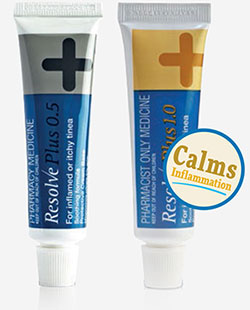Tips & Prevention
Tips to treat and help prevent ringworm
Good hygiene is important to help avoid ringworm. Wash your hands regularly, and avoid sharing clothing and towels or other personal items. It’s also a good idea to wear loose, airy clothes when it’s hot or humid.1
Avoid contact with any pets or other animals that have ringworm (a missing patch of fur may be a sign that they have it) as they could pass it on to you.1
If you have a fungal infection on another part of your body, such as Athlete’s Foot or Jock Itch, be extra careful with your personal hygiene to avoid it spreading and leading to body ringworm.1
If you do get ringworm, Resolve Tinea Cream is an effective treatment.
1. The Mayo Clinic.Overview [Internet].2016 [updated 2016 Nov 5; cited 2017 Mar 8] Available from: www.mayoclinic.org/diseases-conditions/ringworm/home/ovc-20261678








